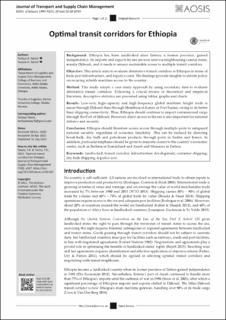| dc.description.abstract | Background: Ethiopia has been landlocked since Eritrea, a former province, gained independence. Its imports and exports by sea are now sent via neighbouring coastal states, mainly Djibouti, and it needs to ensure sustainable access to multiple transit corridors. Objective: This article aims to evaluate alternative transit corridors to Ethiopia in terms of basic port infrastructure, and logistics costs. The findings provide insights to inform policy on securing reliable maritime access to the country. Method: This study adopts a case study approach by using secondary data to evaluate alternative transit corridors. Following a critical review of theoretical and empirical literature, descriptive statistics are presented using tables, graphs and charts. Results: Low-cost, high-capacity and high-frequency global maritime freight trade is easier through Djibouti than through Mombasa in Kenya or Port Sudan, owing to its better liner shipping connectivity. Thus, Ethiopia should continue to import containerised cargo through the Port of Djibouti. However, direct access to the sea is also important for national defence and security. Conclusion: Ethiopia should therefore secure access through multiple ports to safeguard national security, regardless of economic feasibility. This can be realised by directing break-bulk, dry bulk and petroleum products through ports in Sudan and Kenya. In addition, particular emphasis should be given to seaports closest to the country’s economic centre, such as Berbera in Somaliland and Asseb and Massawa in Eritrea. Keywords: landlocked; transit corridor; infrastructure development; container shipping; dry bulk shipping; logistics cost. | en_US |

